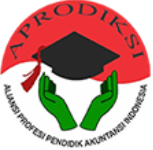Implementation of Accounting Education Learning Through Living Laboratory in MSMEs
(1) Universitas PGRI Madiun
(2) Universitas PGRI Madiun
(3) Universitas PGRI Madiun
Abstract
This study aims to determine the contribution of living laboratory and examine the advantages of living laboratory in MSMEs in Madiun in learning Accounting education, to know and formulate the forms of living laboratory, and formulate living laboratory steps for MSMEs in Madiun in learning Accounting Education. This research method used descriptive-qualitative with a case study approach. The subjects of this study were students who took a course of the business feasibility study of the University of PGRI Madiun. The object of this study was MSMEs in the city of Madiun. The data source in this study consisted of primary and secondary data. The technique of collecting data used observation, interviews and document analysis. Data analysis techniques consisted of data collection, data reduction, data presentation and conclusion (verification). The contribution of living laboratory to MSMEs is that management of living laboratory activities starts from activity planning to the implementation and evaluation of living laboratory activities. The living laboratory learning process supports students’ skills. Living laboratory learning is designed and implemented based on procedures and real work standards. Learning activities of Living laboratory are in addition to achieving mastery of competencies, also emphasizing the development of soft skills that are instilled in the individual students which includes intellectual, emotional, spiritual, and social intelligence.
Keywords
Full Text:
PDFReferences
Indriani, N. (2010). Pengaruh Karakteristik Penggunaan Informasi Akuntansi Terhadap Keberhasilan Usaha Pada Hotel-Hotel Berbintang di Wilayah Surakarta Dan Daerah Istimewa Yogyakarta (DIY). Universitas Gajah Mada Yogyakarta.
Lee Warren and Marilyn N. Young. (2012). Integrated Accounting Principles: A Best Practices Course for Introductory Accounting. Issues in Accounting Education, 27(1), pp. 247–266.
Miles, M. B., & Huberman, A. M. (2009). Manajemen Data dan Metode Analisis. Handbook of Qualitative Reseach. Yogyakarta: Pustaka Pelajar.
Nnenna, O. (2012). The Use Accounting Information as an Aid to Management in Decision Making. British Journal of Science, 5(1), 52.
Putri, Reni, S., & Wardoyo, C. (2017). The Development of Financial Accounting Learning Tools with Gall and Borg Model. Dinamika Pendidikan. Dinamika Pendidikan, 12(2), 86–97. http://doi.org/doi:https://doi.org/10.15294/dp.v12i2.13559
Said, R., Hj Zainuddin, Y., & Haron, H. (2009). The relationship between corporate social responsibility disclosure and corporate governance characteristics in Malaysian public listed companies. Social Responsibility Journal, 5(2), 212–226.
Sohidin. (2016). Peningkatan Kompetensi Lulusan Pendidikan Akuntansi Dengan Proses Pembelajaran Berbasis Simulasi Praktikum Akuntansi Untuk Memenuhi Kebutuhan Industri. Prosiding Seminar Nasional Pendidikan Akuntansi dan Keuangan Pendidikan Akuntansi UNS.
Sudiyanto, Sigit Santoso, Sohidin, E. I. (2015). Pengembangan Living Laboratory Pendidikan Akuntansi Melalui Edukasi Akuntansi pada UMKM (Observasi dan Identifikasi pada UMKM Di Kotasolo, Wonogiri, Sukoharjo, Klaten, Sragen, Boyolali, dan Karanganyar). Prosiding Seminar Nasional Pendidikan Akuntansi Dan Keuangan.
Warsono, S. (2009). Akuntansi ternyata Logis dan Mudah. Yogyakarta: Asgard Chapter.
Warsono, S. (2010). Prinsip-prinsip Akuntansi. Jakarta: Asghard Chapter.
Refbacks
- There are currently no refbacks.

This work is licensed under a Creative Commons Attribution 4.0 International License.

.png)

.png)





